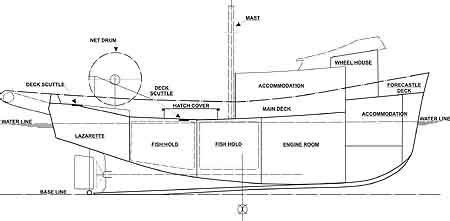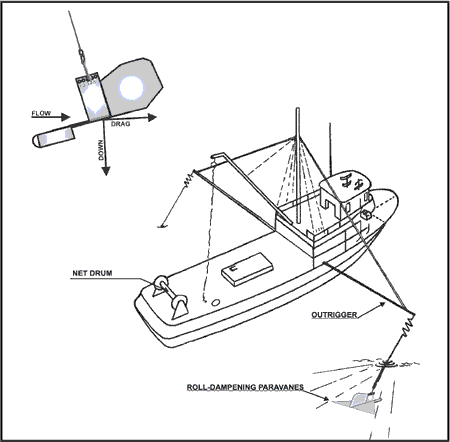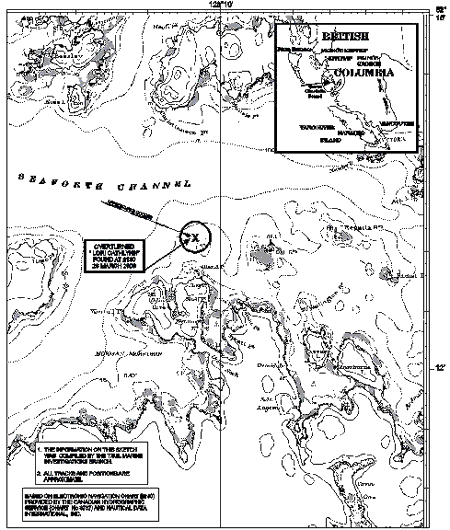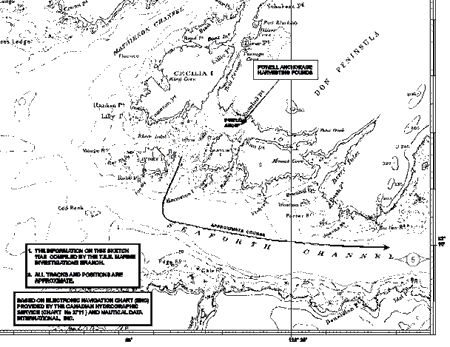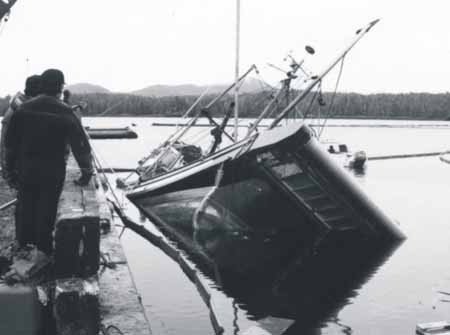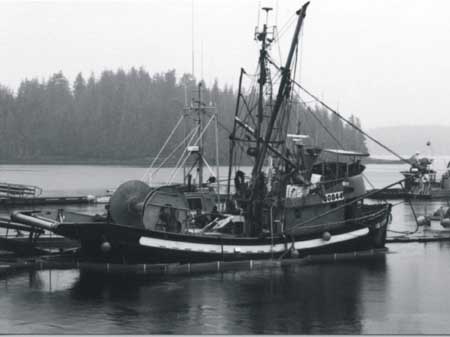Capsizing
The Fishing Vessel Lori Cathlynn
Seaforth Channel
Waglisla (Bella Bella), British Columbia
The Transportation Safety Board of Canada (TSB) investigated this occurrence for the purpose of advancing transportation safety. It is not the function of the Board to assign fault or determine civil or criminal liability. This report is not created for use in the context of legal, disciplinary or other proceedings. See Ownership and use of content. Masculine pronouns and position titles may be used to signify all genders to comply with the Canadian Transportation Accident Investigation and Safety Board Act (S.C. 1989, c. 3).
Summary
While on passage in British Columbia from Powell Anchorage to Waglisla, the small fishing vessel Lori Cathlynn heeled over to starboard, downflooded and capsized to starboard in Seaforth Channel off Campbell Island. The vessel was transporting herring spawn on kelp in tote boxes on deck. The weather and sea were relatively calm at the time. All five members of the crew were safely recovered.
Factual information
Particulars of the vessel
| "LORI CATHLYNN" | |
|---|---|
| Licence Number | 195227 |
| Port of registry | Vancouver, British Columbia |
| Flag | Canada |
| Type | Small Fishing Vessel |
| Gross tonnage | 36.65 |
| Length1 | 15.11 m |
| Breadth | 4.87 m |
| Depth | 1.61 m |
| Built | 1952, Ladner, British Columbia |
| Propulsion | One diesel engine, 165 brake horsepower |
| Crew | 5 |
| Registered Owner | Steve Arnold Carpenter, Richmond, British Columbia |
Description of the vessel
The Lori Cathlynn is a wooden fishing vessel with an aluminum house forward of amidships. The hull is divided into five compartments: forepeak, lower cabin, engine-room, fish hold and lazarette. The lower cabin forward has accommodation for four crew members. The upper deck of the house is aluminum with the wheelhouse occupying the forward part, the skipper's cabin, a washroom and a galley/mess room aft. There are outside ladders from the afterdeck to the cabin top and an inside vertical ladder between the starboard side of the wheelhouse and the lower cabin.
The fish hold is subdivided into three parts. As fish cargo is often transported in a slush-mix of ice and water, the compartments are also termed "fish tanks." The fish holds extend aft, enclosed by the weather deck, upon which a net drum (or reel) is mounted at the stern. Located aft of the superstructure, one deck hatch, with a coaming, gives access to three watertight compartments, which comprise the centrally divided forward port and starboard and the after fish holds. Two small flush deck scuttles are located on each side of the deck hatch, and one small flush deck scuttle located aft gives access to the lazarette. (See Figure 1, Typical layout)
The Lori Cathlynn, like many small fishing vessels on the West Coast, is fitted with roll-dampening paravanes. Held from a vertically hinged pole (outrigger) on each side of the vessel at midships, a roll-dampening paravane consists of a steel, delta-shaped fin connected to approximately 2 m of chain, which is suspended from the outer end of the outrigger by a nylon braided rope. The rope runs from the extreme end of the outrigger and the rope end thimble is shackled to the chain on the suspended paravanes (see Figure 2).
History of the voyage
At approximately 0445 Pacific standard time on 28 March 2000,2 the Lori Cathlynn, with a crew of five, departed Waglisla, British Columbia (B.C.). The vessel was bound for Powell Anchorage on the south coast of the Don Peninsula, where the herring spawn on kelp harvesting pounds are located (see Appendix B). The two forward port and starboard fish tanks were approximately 50 per cent filled with seawater ballast (18,000 lbs). The fuel and fresh water tanks were almost full. During the day the vessel loaded spawn on kelp in 15 totes on decks, for a total load of approximately 9,000 lbs.
At approximately 2000 the vessel left Powell Anchorage. In order to counteract the rolling motion of the ship upon entering the Seaforth Passage, the skipper ordered the roll-dampening paravanes deployed.
At approximately 2130 the vessel took a sudden yaw to starboard and heeled to starboard. The skipper took action by steering to port. For a brief moment the vessel recovered from the starboard roll and again heeled rapidly to starboard, and remained on the starboard side. With the vessel listed approximately 50° to 60° to starboard, the skipper transmitted a Mayday call via VHF channel 7A and set the main engine controls to the "neutral" position. With the assistance of the skipper, the two crew members who were sleeping in the lower cabin were able to climb into the wheelhouse and escape through the port wheelhouse window. The skipper followed them. Meanwhile, the two crew members who were in the galley climbed to the port side of the vessel. In less than two minutes, the vessel progressively downflooded and capsized, but remained afloat (see Appendix A). The crew did not have time to collect or don either immersion suits or life jackets but managed to climb onto and stand on the upturned hull.
In response to the Mayday broadcast, a nearby fishing vessel, the Back Eddy, was able to rescue the survivors within approximately five minutes. The Fast Rescue Craft from the Department of Fisheries and Oceans in Bella Bella arrived on scene around 2140 to assist in the rescue. One member of the crew was transported to the hospital in Waglisla, B.C., where he received treatment for mild hypothermia.
The Lori Cathlynn was taken in tow to Shearwater, B.C., for salvage, inspection and repairs (see Appendix C, Photos 1 and 2).
There was no injury or pollution as a result of this occurrence.
Department of Fisheries and Oceans Licences
According to the information received from the Department of Fisheries and Oceans, the Lori Cathlynn has not been designated as a catcher vessel for a herring spawn on kelp licence. The vessel would be permitted to transport herring spawn on kelp under the authority of the "CA" licence. This type of licence is issued to vessels typically when salmon licences are not yet available for issue in a given year. It is granted to vessel owners who wish to participate in transporting activities or to fish for Schedule II Category "C" species. Both these activities are permitted under the authority of a salmon "A" licence.
Vessel Certification, Training and Personnel History
The Lori Cathlynn was issued a Ship Inspection Certificate (SIC 29) by Transport Canada, Marine Safety (TCMS) valid until 15 June 2002.
To command a fishing vessel of the size and type of the Lori Cathlynn, the Crewing Regulations do not provide requirements for the employment of master and mates in respect of a fishing vessel or ship engaged in transferring to shore the catch of a fishing vessel. The skipper was not required to hold a Transport Canada certificate to command a fishing vessel of this size and type. The skipper on board the Lori Cathlynn had extensive experience operating fishing vessels of similar tonnage.
With the exception of the skipper, none of the other crew members had attended Marine Emergency Duties (MED) training nor were they required to do so under the Canada Shipping Act (CSA) regulations. However, Transport Canada has submitted an amendment to the Crewing Regulations that will require all Fishing Vessel crew members to attend MED training by 30 July 2002.
Weather and Current Information
The weather was described as overcast and dark, with southwesterly winds at 10 knots and with small wavelets. The weather was not a factor in this occurrence. Canadian Hydrographic Service Chart No 3787 indicates variation of depth from 30 to 14 fathoms at the location of the occurrence, in approximate position 52°13.0′ N, 128°10.13′ W.
Stability Requirements
Further to modifications carried out to the vessel in 1989, the review of the vessel's roll test report submitted to TCMS indicates that the vessel's stability for fishing operations is adequate. This report is for the worst operating condition, with brine in the forward fish holds, ice or dry cargo in the aft hold, and no deck cargo. Small fishing vessels engaged in packing operations (not engaged in the herring or capelin fisheries) are not required to submit stability data. Evaluation of the stability of the vessel in 1989 was completed by a firm of naval architects and consultants and found acceptable by the TCMS office. No modifications had been made to the hull or equipment since that date.
The stability conditions reflecting the vessel's loading conditions and modes of operation were not calculated and were not required to be submitted for regulatory approval. Loading, trim, and stability conditions for the vessel were not carried on board, nor were they available for the guidance of the skipper when operating as a packer or in fishing operations.
Life-saving Equipment
In accordance with Transport Canada requirements, the life-saving equipment on board the vessel included an approved life jacket for each person on board. The vessel also carried immersion suits for each person on board to meet the requirements of Part 24 of the Diving, Fishing and Other Marine Operations Regulations made pursuant to the B.C. Workers' Compensation Act; there is no requirement for the carriage of immersion suits for such vessels in the Canada Shipping Act (CSA) regulations.
Under the Small Fishing Vessel Inspection Regulations, the Lori Cathlynn, being less than 20 m long, was not required to carry an emergency position indicating radio beacon.
According to the report of the last inspection completed by TCMS, the vessel was required to carry an aluminum skiff and an inflatable life raft for eight persons. At the time of the occurrence neither an aluminum skiff nor a life raft were on board the vessel.
Analysis
Watertight Integrity of Hatch and Deck Scuttles
The flush deck scuttles of the lazarette and of the port fish hold were missing and the main hatch of the fish holds was not in place when the vessel was recovered. The deck scuttles were lost, indicating that they had not been secured. Although required by regulations, the deck scuttle cover was neither hinged nor secured by a chain to the vessel's structure. The sudden heeling and the action of sea water swamping the vessel's deck would have dislodged them from the hatch coamings, allowing the ingress of water. The resultant downflooding of the lazarette and of the fish hold would have increased the heel and hastened the capsizing.
Reduction of Transverse Stability
The free surface effect of a liquid's movement within a ship raises its virtual centre of gravity and consequently reduces the transverse metacentric height. Since metacentric height is an indicator of a ship's initial transverse stability, the elimination or reduction of free surface is essential in maintaining a vessel's stability. The initial free surface effect was created when the fish holds were partially filled with ballast water prior to the vessel's departure. This caused the vessel's starboard list to progressively increase as more seawater downflooded through the unsecured deck scuttle and hatch cover. Unless the fish holds were maintained full to the underside of the hatch cover, or remained totally empty, the vessel would be subjected to the dangerous movement of ballast water.
Post-occurrence calculations based on a cargo of 15 totes on deck (a conservative load of 9,000 pounds) in conjunction with the concurrent free surface effects of the partially ballasted forward port and starboard fish holds, with half full oil fuel and fresh water tanks, show that the vessel's transverse initial and dynamic stability characteristics were markedly reduced below the regulatory minimum dynamic stability criteria. The vessel's watertight integrity was compromised by unsecured hatch covers and scuppers on the main deck. The accumulation of these detrimental effects placed the Lori Cathlynn in a highly vulnerable condition.
Impact of Roll-Dampening Paravanes
Roll-dampening paravanes were fitted to the Lori Cathlynn on port and starboard outriggers attached to the bulwarks. The paravanes were in use at the time of the occurrence. Post-occurrence inspection of the vessel showed that the cable to the starboard paravane stabilizer was ruptured at the eyelet's extremity. The paravane could not be found on the vessel. It could not be ascertained if it was lost at the time of the occurrence or while towing the upturned vessel the following day.
When both paravanes are deployed, they are lowered into the water - port and starboard - from the extended outriggers. When dragged through the water, each paravane exerts a downward force by the diving effect of its fin. This balanced downward pulling force at the end of each outrigger makes the moving vessel more resistant to heeling forces, and dampens roll (see Figure 2).
The use of roll-dampening paravanes is not without risk. The safe functioning of the submerged delta-shape is largely dependent on the towing speed and on their complementary operation - to port and starboard - such that the righting moment caused by the downward force generated on one side is synchronized with the upward roll of the vessel on that same side. If the port and starboard synchronization is disturbed or lost, an athwartships moment can be applied to the vessel when she is rolling toward the paravane generating the most downward force, and the vessel's roll may actually be increased on that side. The synchronous and complementary operation would be significantly disturbed if one paravane became fouled on an obstruction. In addition, the skipper's action of steering to port when the vessel was heeling to starboard would have unfortunately affected the heeling to starboard.
Findings
Findings as to causes and contributing factors
- The free surface effect of the liquids in the two partially filled fish tanks reduced the vessel's transverse stability prior to departure.
- On the return voyage the vessel had a deck load of 15 totes of herring spawn on kelp on deck and oil fuel and fresh water tanks were slack, markedly reducing the vessel's transverse stability. There is no record of the quantities of liquids carried on board before the capsizing.
- The roll-dampening paravanes were being used at the time of the occurrence.
- A combination of the dynamic heeling effect of the paravane on the starboard side, free surface effects of the liquids and a load of herring spawn on deck reduced the vessel's righting ability, causing it to roll to starboard and to heel rapidly.
- The vessel's watertight integrity was compromised by unsecured hatch covers and scuttles on the main deck allowing downflooding to take place.
- The deck scuttle covers were neither hinged nor secured by a chain to the vessel's structure.
Other findings
- The Small Fishing Vessel Regulations do not provide guidance for the safe design, installation and operation of roll-dampening paravanes.
- The crew had to abandon the rapidly capsizing vessel without personal life-saving appliances.
- Although required by TCMS, neither an aluminum skiff nor a life raft were on board the vessel.
- The master was able to send a distress call and all on board were rescued by a nearby vessel.
- The skipper was not required to hold a Transport Canada certificate to command a fishing vessel of this size and type.
- There is no current requirement in Canada for the crew of a small fishing vessel of under 100 GRT to undergo any training, including MED courses.
- The stability of small Canadian fishing vessels is not subject to detailed regulatory analysis or approval, unless the vessel is employed in catching herring or capelin.
Safety action
Action taken
Following this occurrence, the TSB forwarded Marine Safety Information (MSI #004/00) to Transport Canada, Marine Safety (TCMS), concerning the shortcomings in stability characteristics of the Lori Cathlynn.
In response, TCMS indicated that they have re-inspected the vessel and carried out a roll test. The vessel is presently back in operation with the following conditions limiting its operation:
- the forward fish hold centerline bulkhead's extension to be in place at all times except when the net is stored in the hold, and
- free surface effects to be reduced to a minimum (hold full /empty) when carrying tote boxes on deck (herring spawn on kelp ), and a minimum freeboard of 0.46 metre (18 inches) to be maintained in the fully loaded condition.
Furthermore, TCMS indicated that they will issue a Ship Safety Bulletin, making recommendations respecting the improper loading encountered in this occurrence.
This report concludes the Transportation Safety Board's investigation into this occurrence. Consequently, the Board authorized the release of this report on .
<a name="Appendix_A" id="Appendix_A"></a>Appendix A - Sketch of the Occurrence Area
<a name="Appendix_B" id="Appendix_B"></a>Appendix B - Sketch of the Harvesting Area
<a name="Appendix_C" id="Appendix_C"></a>Appendix C - Photos
Photo 1. Salvage of the Lori Cathlynn.
Photo 2. The Lori Cathlynn after recovery.
1. Units of measurement in this report conform to International Maritime Organization standards or, where there is no such standard, are expressed in the International System of units.
2. All times are Pacific standard time (coordinated universal time minus eight hours).
